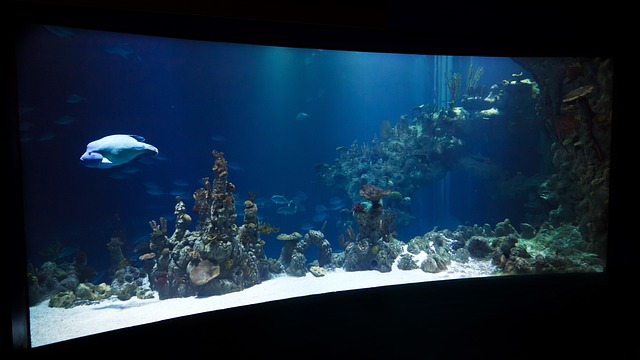Underwater cities, once mythical, are now closer to reality thanks to technological advancements and architectural innovation. Custom coral reef tanks serve as both beautiful home accents and sustainable solutions for overpopulation, resource scarcity, and climate change. These meticulously designed ecosystems replicate underwater environments, fostering human connection with nature and promoting biodiversity. The trend in urban design integrates these tanks into cityscapes, creating harmonious spaces that merge natural landscapes with modern architecture.
Underwater cities have long captivated our imaginations, evolving from mythic realms to potential realities. This article explores the fascinating intersection of architecture and the ocean, delving into historical aspirations, modern innovations like custom coral reef tanks, and the fusion of aquatic concepts with land-based design. We examine trends that hint at a future where natural landscapes and modern architecture seamlessly merge, offering a glimpse into a world where water and stone coexist harmoniously.
The Allure of Underwater Cities: A Historical Perspective
Underwater cities have long captivated the human imagination, appearing as both a futuristic utopia and a challenge to our existing understanding of urban living. Historically, the allure of underwater habitats can be traced back to early myths and legends, with stories of Atlantis and other mythical sea civilizations inspiring countless works of art and literature. While these accounts were once purely fantastical, technological advancements in diving suits, aquariums, and underwater construction have brought the concept closer to reality.
In recent years, architects and designers have explored the potential for custom coral reef tanks and other innovative underwater structures as a means to address overpopulation, resource scarcity, and climate change. These visions range from semi-submerged cities connected to shore by tunnels to entirely autonomous underwater habitats capable of supporting complex ecosystems. The allure of underwater cities lies not only in their aesthetic beauty but also in the potential for sustainable living, with designed reef tanks serving as both habitat and source of food, oxygen, and other resources.
Custom Coral Reef Tanks: Bringing the Ocean to Land
Imagine a space where the vibrant hues of coral and the dance of marine life mimic the beauty of the ocean, all within the confines of your home. Custom coral reef tanks make this vision a reality. These meticulously designed aquariums aren’t just water-filled boxes; they are miniature ecosystems that replicate the intricate balance and stunning visuals of underwater cities. Crafted with precision, these tanks become focal points, transforming interiors into serene aquatic sanctuaries.
The heart of these designs lies in their customization. From size and shape to the specific types of coral and marine species housed within, each tank is tailored to suit individual preferences and space constraints. This level of personalization allows homeowners to create a unique underwater world, fostering a connection with nature and offering a glimpse into the intricate architecture of the ocean’s depths.
Architectural Synergies: Translating Aquatic Concepts onto Land
The concept of an underwater city, while once confined to science fiction, is now gaining traction as architects and designers explore innovative ways to integrate aquatic environments into their projects. This trend has led to a fascinating interplay between architecture and the ocean, with designs that draw inspiration from the fluidity and complexity of marine ecosystems. One notable synergy emerges through the creation of custom coral reef tanks, which not only serve as visual marvels but also offer a sustainable approach to urban development. These intricate structures mimic natural reefs, supporting diverse marine life while providing a unique aesthetic for coastal communities.
By studying the organic shapes and intricate patterns found in coral formations, architects can translate these aquatic concepts onto land, resulting in stunning buildings that seem to grow organically from their surroundings. Custom coral reef tanks, integrated into both residential and commercial spaces, can serve as focal points that educate and inspire. This fusion of architecture and marine biology not only creates visually captivating spaces but also fosters a deeper connection between humans and the ocean, highlighting the potential for sustainable and harmonious coexistence in our built environment.
Future of Urban Design: Merging Natural Landscapes with Modern Architecture
The future of urban design is an intriguing concept that merges natural landscapes with modern architecture, creating sustainable and harmonious spaces. This innovative approach draws inspiration from underwater cities, where man-made structures coexist with organic elements beneath the waves. By incorporating custom coral reef tanks into cityscapes, architects can craft eco-friendly habitats that support marine life while offering breathtaking visual experiences for residents and visitors alike.
Such integrated designs blur the lines between artificial and natural environments, promoting biodiversity and enhancing urban aesthetics. Custom coral reef tanks, strategically placed within public areas or as part of residential complexes, not only serve as functional features but also become iconic landmarks that capture the imagination. This trend reflects a growing awareness of our interconnectedness with nature and a desire to create cities that are both vibrant and environmentally conscious.
The exploration of underwater cities and architecture-inspired designs showcases a fascinating fusion of natural landscapes and modern innovation. With historical allure and contemporary advancements, we’ve seen the potential of custom coral reef tanks to bring the ocean’s beauty onto land, while architectural synergies translate aquatic concepts into groundbreaking urban design. As we look towards the future, merging natural environments with modern architecture holds immense promise for creating sustainable and captivating living spaces that resonate with our deep connection to water.
